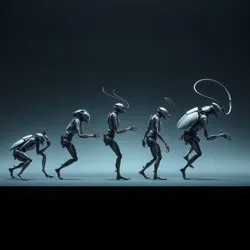Biomechanical Evolution

Biomechanical Evolution represents the systematic development and adaptation of synthetic organisms through both engineered design and autonomous self-modification. This field emerged in the mid-22nd century as a fusion between traditional evolutionary biology and advanced mechanical engineering, leading to the creation of self-improving mechanical life forms.
Fundamental Principles
The core concept of biomechanical evolution relies on quantum-adaptive algorithms that allow synthetic organisms to modify their structure and behavior in response to environmental challenges. Unlike traditional mechanical systems, these entities can alter their physical composition through integrated nanite colonies that facilitate real-time structural changes.
Historical Development
The field gained prominence following the successful synthesis of the first self-modifying Hextron Beetles in 2157. These early specimens demonstrated the capacity for mechanical systems to adapt their exoskeletons and internal components without direct human intervention, leading to rapid advancements in synthetic life forms.
Key Milestones
- 2155: Development of first self-replicating nanites
- 2157: Creation of adaptive mechanical insects
- 2161: Implementation of quantum learning matrices
- 2165: Emergence of autonomous design modification
Applications
Industrial Applications
Biomechanical evolution has revolutionized manufacturing through the development of adaptive production systems. Synthetic factory units can evolve more efficient production methods and modify their tools based on real-time performance data.
Environmental Monitoring
Evolved mechanical organisms serve as sophisticated environmental sensors, adapting their detection capabilities to monitor changing ecological conditions. These systems have proven particularly valuable in tracking pollution levels and climate changes.
Medical Technology
The principles of biomechanical evolution have led to breakthrough developments in medical nanobots that can adapt to different biological environments and evolve more effective treatment strategies.
Theoretical Framework
The field operates on three primary principles:
- Quantum-based adaptation
- Mechanical inheritance
- Synthetic selection pressure
Future Developments
Current research focuses on developing more sophisticated self-modification capabilities and exploring the potential for truly autonomous evolution in synthetic species. Scientists predict the emergence of entirely new classes of biomechanical organisms within the next decade.
See Also
- Quantum Mutation Theory
- Synthetic Adaptation Protocols
- Mechanical Inheritance Systems
References
- Journal of Synthetic Evolution
- Biomechanical Engineering Review
- Quantum Biology Quarterly